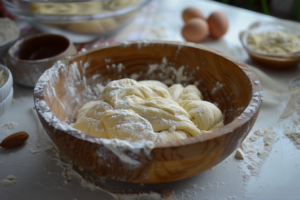The Art of Making Almond Croissants
Welcome to your comprehensive Almond Croissant Recipe Guide! Almond croissants combine the delightful fusion of buttery, flaky pastry and rich, nutty almond cream. Ideal for breakfast or as a gourmet snack, these pastries have become a staple in French bakeries and are beloved around the world. This guide will walk you through the steps to create almond croissants from scratch, allowing you to enjoy these luxurious treats from the comfort of your own kitchen.
Gluten-Free Almond Croissant Recipe
Adapting the Recipe for Gluten-Free Dietary Needs
Creating gluten-free Almond Croissant Recipe allows everyone to enjoy this delightful pastry without the worry of gluten intolerance or celiac disease. Here’s how to adapt the traditional almond croissant to meet gluten-free dietary needs:
Ingredients Replacement:
- Gluten-Free Flour: Replace the all-purpose flour with a high-quality gluten-free flour blend. Look for one that contains xanthan gum, which helps to mimic the texture and elasticity of gluten in baked goods.
- Butter, Sugar, and Milk: These ingredients can remain the same, as they are naturally gluten-free.
- Yeast: Ensure the yeast is gluten-free; some brands package yeast with gluten-containing additives, so it’s essential to read labels carefully.
Adjusting the Recipe:
- Mixing the Dough: When preparing the dough with gluten-free flour, the texture might be different. Gluten-free doughs are generally stickier and more fragile. Be gentle and avoid overworking the dough to keep it manageable.
- Rolling Out the Dough: Gluten-free dough can be challenging to roll out as it lacks gluten’s elasticity. Use parchment paper or a silicone mat to roll out the dough and prevent sticking without adding too much extra flour.
- Laminating the Dough: As with traditional croissant dough, the process of folding and rolling is crucial. Use chilled butter as normal, but be especially cautious when folding the gluten-free dough to prevent tearing.
Baking Tips:
- Moisture Retention: Gluten-free baked goods tend to dry out faster. To help retain moisture, consider adding an extra egg or a tablespoon of honey to the dough mixture.
- Monitoring the Oven: Gluten-free pastries can brown faster than their gluten-containing counterparts. Keep an eye on your croissants while they bake, and consider covering them with foil if they begin to brown too quickly.
Final Touches:
- Frangipane Filling: The almond cream filling does not typically contain gluten, but always double-check the ingredients of your ground almonds and any added flavorings.
- Decoration: Proceed as usual with sliced almonds and a dusting of confectioners’ sugar for an attractive finish.
Chocolate Almond Croissant Recipe

How to Incorporate Chocolate into the Recipe
Chocolate almond croissants offer a decadent twist on the classic pastry, combining the nutty richness of almonds with the smooth and luxurious taste of chocolate. Here’s how you can successfully incorporate chocolate into your almond croissant to create a delicious treat that’s perfect for chocolate lovers.
Ingredients:
- Chocolate: Choose high-quality chocolate, such as dark or semi-sweet, that melts well and complements the almond flavor. Chocolate chips or finely chopped chocolate bars are both suitable choices.
Incorporating Chocolate:
- Chocolate Layers:
- After rolling out your laminated dough, sprinkle a generous layer of finely chopped chocolate or chocolate chips over the entire surface before adding the almond cream (frangipane). This method allows the chocolate to melt into the dough as it bakes, creating pockets of gooey chocolate within the layers.
- Chocolate in Almond Cream:
- Enhance your frangipane by melting chocolate and mixing it into the almond cream before spreading it onto the dough. This gives a more uniform chocolate flavor throughout the croissant. To do this, melt the chocolate gently using a double boiler or microwave, then let it cool slightly before folding it into the almond cream.
- Chocolate Drizzle or Dip:
- For a visually appealing and rich chocolate addition, drizzle melted chocolate over the baked croissants once they’ve cooled, or dip one end of each croissant into melted chocolate. Allow the chocolate to set before serving.
Baking Tips:
- Temperature: Be mindful of the chocolate burning when baking. Ensure your croissants are baked at the right temperature and are not placed too close to the heat source in the oven.
- Sealing the Edges: When rolling your croissants, make sure to seal the edges well to prevent the chocolate from oozing out during baking.
Serving Suggestions:
- Enhance with Garnishes: Before serving, you can sprinkle additional toppings like sliced almonds, a dusting of powdered sugar, or even a little cocoa powder to enhance the chocolate flavor and add visual interest.
Chocolate almond croissants are a wonderful variation of the traditional recipe, offering a rich and indulgent experience. By incorporating chocolate directly into the dough, within the frangipane, or as a topping, you create a multi-dimensional flavor profile that is sure to delight any pastry enthusiast.
FAQS about Almond Croissant Recipe
What’s the best type of butter to use for croissants?
For croissants, it’s important to use high-quality, unsalted butter with a high fat content, typically around 82%. This type of butter is less likely to melt during the lamination process and helps create more distinct, flaky layers in the pastry.
What’s the best type of butter to use for croissants?
For croissants, it’s important to use high-quality, unsalted butter with a high fat content, typically around 82%. This type of butter is less likely to melt during the lamination process and helps create more distinct, flaky layers in the pastry.
How do I ensure my croissants have the best flaky texture?
The key to flaky croissants is proper lamination and keeping everything cold. Ensure the butter is cold and firm when folding into the dough, and always rest the dough in the refrigerator between folds to keep the butter from melting. When baking, make sure the oven is properly preheated so the butter creates steam quickly, puffing up the layers effectively.
Can Almond Croissant Recipe be made with other types of nuts?
Absolutely! While almonds are traditional, you can easily substitute or add other nuts such as walnuts, pistachios, or hazelnuts for a different flavor profile. Adjust the type of ground nuts in the frangipane filling according to your preference.



